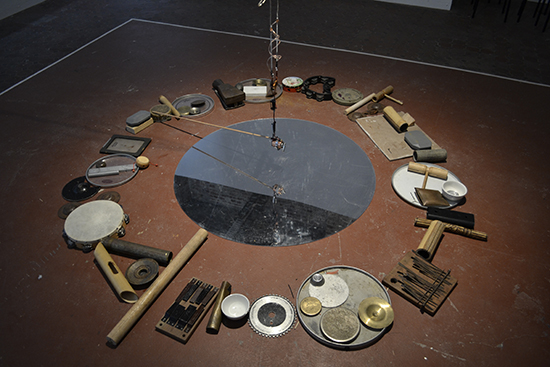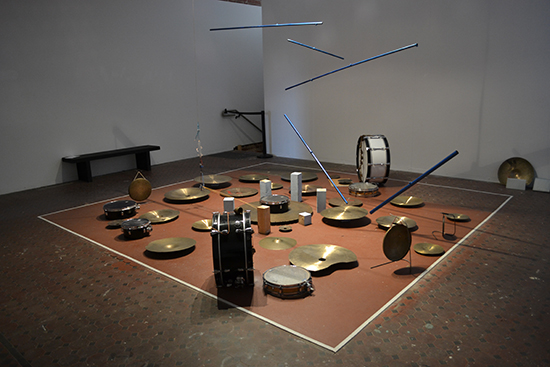Counterbalancing chaos
Gail Priest: Robbie Avenaim’s Motorgenic, Substation

Motorgenic, Robbie Avenaim, Substation
photo Amanda Betlehem
Motorgenic, Robbie Avenaim, Substation
I’m chatting with Robbie Avenaim amid the rattle, clash and clatter of his Motorgenic exhibition at Melbourne’s Substation when he explains that this is a retrospective not of his work, but of his instrument, the Electronic Motorised Stick (EMS). He says this with a real affection and respect that stops just shy of anthropomorphic. This sentiment is affirmed as he goes on to describe his robotic creations not simply as instruments but as collaborators that he uses to push his own skills as an improvising musician.
Given Avenaim developed his Semi-Automated Robotic Percussion System (SARPS) as a performance tool, it’s fascinating to see the methodology very successfully deployed as a series of kinetic sound sculptures. If you approach the three-room installation in a roughly clockwise direction, you experience the evolution of Avenaim’s collaborative partner from shop-purchased vibrator (cheekily presented on a plinth, under glass, like a precious archaeological artefact) to the first model Electronic Motorised Stick whose sideways action is limited to playing a single drum, to the 360 degree multi-instrumental version. Then on to his latest work which sees the stick robot let loose on both vertical and horizontal planes. The learning process for both artist-maker and robotic instrument is clear, each new variation refining the “musculature” and increasing the range to include even more interaction with chance.
The first Electronic Motorised Stick was the EMS180°. Inspired by the mechanics of the vibrator that he had been using in his expanded percussion performances (a short sample of which is included on a small monitor in the room), Avenaim attached a small DC motor with a counterbalance to a drumstick and then strung it up so that it could hit things. In this first iteration the stick is constrained to a 180° range by two metal rods attached to the frame of a tom tom. The drum is covered in felt and on it is placed a small gong. Consequently, rather than an arrhythmic drum roll, the sonic results are soft thuds, metallic thunks and an occasional higher ring as the stick makes contact with the gong that wobbles around the surface trying to escape the beating. The modification of the drum and its surface indicates that Avenaim’s interest is in creating unexpected sonic outcomes, not simply in the perceived novelty of autonomous playing.

Motorgenic, Robbie Avenaim, Substation
photo Amanda Betlehem
Motorgenic, Robbie Avenaim, Substation
Releasing the EMS from its metallic bondage, the second installation, EMS 360° sees the vibrating stick suspended in a long drop from the ceiling and mechanised so that it continuously rotates in clockwise direction. As it does so it makes contact with a circle of carefully placed objects on the floor—metal pipes, gongs, porcelain bowls, woodblocks. Set to a fast frequency, the hyperactive stick skips across the objects that are all differently textured, yet have a similar bright hollow timbre— a ‘tick tocki-ness.’ This is a music of relentless action—sonic markers of seconds irregularly tripping away much faster than Greenwich Mean Time.
The final installation EMS 360° Mobile, allows the motorised stick access to movement not only across the horizontal but also the vertical plane. While this introduces more chaos, curiously the result is less hyperactive and more mesmeric than the previous installation. This has to do with the speed of the stick’s frequency and its length but also with the hovering grace of the large-scale mobile that Avenaim has constructed from long metal tubes to counterbalance the vibrating stick. Subtitled “a work-in-progress,” this exploratory feel is built into the work as the stick tests the territory, tapping its way across the floor, on which are placed large cymbals, bass drums and snares that produce a weightier breed of percussive sounds.
Like an obstacle course or training ground there is also a range of wooden blocks among the instruments that encourage the EMS to ascend to different heights and to bounce to different areas of the playing field. Here you can really see the machine negotiating its environment as the stick gets caught in little micro-rhythms between objects before ricocheting off into other new zones and patterns. Nothing is repeatable and almost anything is possible, yet there are clearly rules at work—mechanical, mathematical, physical and aesthetic. While I’m in the gallery Avenaim adjusts some of the objects and the instrument recalibrates itself to a new world order. “In-progress” is the very nature of this piece: it can never, and should never be resolved.
During our conversation, Avenaim is keen to emphasise that for him, this exploration has always been about how to be a better musician by learning from these mechanised minds. It is this humble yet deeply conceptual engagement that makes these works so elegant and convincing as kinetic installations. The form is very much defined by the function, opening up the awe of physics-in-action. This is best illustrated by the small study-type work in the first room that comprises a metal ring suspended 30cms off the floor. As the DC motor in the ceiling turns the metal object spins in a beautiful undulating arc—like rings orbiting a planet. I asked Avenaim about this curiously silent work and he said that when he installed it, it was touching the floor so that the circling produced a metallic sound, but that the continuous action has caused it to wind around itself, gradually lifting the ring further and further off the ground. He prefers to leave it this way, seeing the work now as a visual study of oscillating frequencies. It’s this sense of curiosity and wonder that makes Robbie Avenaim’s Motorgenic a very satisfying and cohesive exhibition, visually, sonically and conceptually.
See videos of works in Motorgenic here and here.
Robbie Avenaim, Motorgenic, The Substation, Newport, Melbourne, 17 Nov-17 Dec
RealTime issue #136 Dec-Jan 2016 pg.






